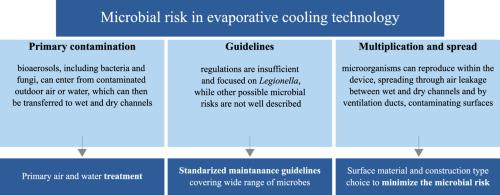蒸发冷却的挑战和未来方向:平衡可持续冷却与微生物安全
IF 7.1
1区 工程技术
Q1 CONSTRUCTION & BUILDING TECHNOLOGY
引用次数: 0
摘要
蒸发冷却系统因其环保优势而越来越受欢迎,特别是在降低能耗和利用空气(R-729)和水(R-718)作为制冷剂方面。然而,这些系统很容易受到微生物污染,对健康构成重大威胁,尤其是在空气与水直接接触的环境中。文章深入分析了与蒸发冷却系统相关的微生物风险,重点介绍了嗜肺军团菌、真菌和其他病原体等细菌,这些细菌会在这些系统所创造的潮湿环境中大量繁殖。虽然军团菌污染已被充分证实并经常被处理,但这项研究强调了对其他微生物风险进行更全面评估的必要性。研究比较了蒸发冷却系统和传统蒸汽压缩冷却系统的微生物安全性,并考察了冷却垫材料和水质在促进微生物生长方面的作用。研究还强调了当前维护方法的局限性,因为这些方法往往忽视了非军团菌风险。为了提高微生物安全性,论文提出了几种缓解策略,包括紫外线水处理和热交换器表面改造,以减少微生物污染。此外,研究还呼吁制定更详细、更一致的维护指南,涵盖军团菌以外的更广泛的微生物威胁,并定期监测室内空气质量,以确保这些系统在有人居住的空间内安全运行。最终,研究结果强调,通过改进微生物安全协议和定期维护,蒸发冷却系统可以成为各种环境中传统冷却技术的可持续安全替代品。本文章由计算机程序翻译,如有差异,请以英文原文为准。

Challenges and future directions in evaporative cooling: Balancing sustainable cooling with microbial safety
Evaporative cooling systems are gaining popularity due to their environmental benefits, particularly in reducing energy consumption and utilizing air (R-729) and water (R-718) as refrigerants. However, these systems are susceptible to microbial contamination, posing significant health risks, especially in environments where air is in direct contact with water. The article provides an in-depth analysis of the microbial risks associated with evaporative cooling systems, focusing on bacteria such as Legionella pneumophila, fungi, and other pathogens that can proliferate in the moist environments these systems create. While Legionella contamination is well-documented and frequently addressed, this study highlights the need for more comprehensive evaluation of other microbial risks. The research compares the microbial safety of evaporative cooling systems with that of traditional vapor compression cooling and examines the role of cooling pad materials and water quality in promoting microbial growth. It also underscores the limitations of current maintenance practices, which often overlook non-Legionella risks. To improve microbial safety, the paper proposes several mitigation strategies, including UV water treatment and heat exchanger surface modifications, to reduce microbial contamination. Additionally, the study calls for more detailed and consistent maintenance guidelines that cover a broader spectrum of microbial threats beyond Legionella, as well as regular monitoring of indoor air quality to ensure the safe operation of these systems in human-occupied spaces.
Ultimately, the findings emphasize that, with improved microbial safety protocols and regular maintenance, evaporative cooling systems can become a sustainable and safe alternative to conventional cooling technologies in various environments.
求助全文
通过发布文献求助,成功后即可免费获取论文全文。
去求助
来源期刊

Building and Environment
工程技术-工程:环境
CiteScore
12.50
自引率
23.00%
发文量
1130
审稿时长
27 days
期刊介绍:
Building and Environment, an international journal, is dedicated to publishing original research papers, comprehensive review articles, editorials, and short communications in the fields of building science, urban physics, and human interaction with the indoor and outdoor built environment. The journal emphasizes innovative technologies and knowledge verified through measurement and analysis. It covers environmental performance across various spatial scales, from cities and communities to buildings and systems, fostering collaborative, multi-disciplinary research with broader significance.
 求助内容:
求助内容: 应助结果提醒方式:
应助结果提醒方式:


